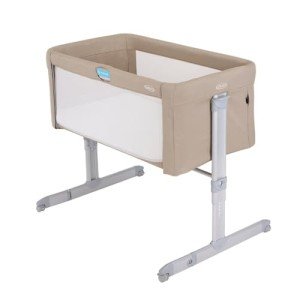Is Your Company Responsible For The Bedside Cot For Sleeping Arrangements Budget? 12 Tips On How To Spend Your Money
Understanding Bedside Cots for Sleeping Arrangements: A Comprehensive Guide
As new parents, establishing a safe and comfortable sleeping environment for their newborns is paramount. Bedside Cot For Nursing offers a practical service that permits caretakers to keep their infants close throughout the night while guaranteeing safety. This article explores the idea of bedside cots, their benefits, different types available on the marketplace, and essential elements to think about when picking the best one.
What is a Bedside Cot?
A bedside cot, frequently described as a co-sleeper or bedside sleeper, is a kind of infant bed that attaches firmly to the side of the parent's bed. This ingenious design allows parents to access their newborns quickly while keeping a separate sleeping area, thus promoting safe sleep practices.
Key Features of Bedside Cots:
Feature
Description
Attachment
Bedside cots can be securely connected to the parents' bed, helping to prevent falls.
Adjustable Height
Lots of models include adjustable heights to fit various bed sizes, making sure compatibility.
Drop-Side Cradle
Some designs include a drop-side that enables caretakers to reach the baby without rising.
Fit together Sides
Fit together sides promote air flow and exposure, enabling parents to monitor their baby conveniently.
Portable Design
Many bedside cots are lightweight and can be quickly moved from one room to another.
Benefits of Using a Bedside Cot
1. Easy Access to the Baby
Among the most substantial benefits of a bedside cot is that it enables parents to tend to their newborn without fully getting up or rising. This ease of access can be especially useful during over night feedings and diaper changes.
2. Promotes Bonding
Having the baby close by promotes bonding and emotional security for both the infant and the moms and dad. The proximity enables parents to hear and react to their baby's needs quicker, fostering a sense of trust and comfort.
3. Safety Benefits
Bedside cots help minimize the danger of SIDS (Sudden Infant Death Syndrome) as they encourage safe sleeping practices. With a separate sleep space, parents can prevent bed-sharing dangers like unintentional suffocation.
4. Convenience
Bedside cots are often portable, making them convenient for travel or simply moving between various locations of the home. They typically feature functions like storage pockets for basics, even more boosting their utility.
Types of Bedside Cots
When thinking about a bedside cot, it's necessary to comprehend the numerous types offered on the marketplace, as each offers distinct features and advantages:
1. Flooring Bedside Cots
These cots are designed to sit straight on the floor and provide a low-profile option for co-sleeping. They are particularly appropriate for parents who prefer a minimalistic approach.
2. Adjustable Bedside Cots
These are more versatile, created to connect to the parent's bed and adjust in height. Lots of models also enable the side to lower, supplying easier access to the baby.
3. Travel Bedside Cots
Portable and typically collapsible, these cots are ideal for households on the go. They are light-weight, compact, and created for travel benefit without sacrificing comfort for the baby.
4. Convertible Bedside Cots
Some bedside cots can convert into various types of furnishings, such as a playpen or young child bed, extending their use as the kid grows.
Factors to Consider When Choosing a Bedside Cot
Choosing the ideal bedside cot involves careful factor to consider of several essential factors:
Safety StandardsMake sure the cot meets safety guidelines and requirements, including appropriate products and design to prevent any dangers of entrapment or falling.
Size and CompatibilityInspect the dimensions of the cot and verify that it can be safely connected to your bed. Compatibility with different bed types is essential.
Ease of UseTry to find features that improve functionality, such as adjustable heights, collapsible designs for travel, or mesh sides that supply ventilation and presence.
Stability and DurabilityPick a bedside cot made from tough, premium materials to make sure stability and longevity, specifically if you plan to use it for several kids.
Reduce of CleaningLots of parents neglect this aspect. Opt for designs with detachable, washable fabrics to keep health quickly.
FAQs About Bedside Cots
Q: Are bedside cots safe for newborns?A: Yes, when
used correctly, bedside cots can develop a safe sleeping environment for newborns. They comply with security policies and provide a dedicated sleep space.
**Q: How long can my baby use a bedside cot?A: Most bedside cots are appropriate for newborns as much as about six months or until the baby can sit up unaided. Constantly check the maker's guidelines for particular age and weight limitations. Q: Can I use a bedside cot with a bed that has
a high mattress?A: Many adjustable bedside cots accommodate a series of mattress heights.
It's essential to pick one that can be raised or decreased to match your bed. Q: What if my baby rolls around often?A: Installing a bedside cot firmly with appropriate safety functions decreases threats. Please guarantee it is at the very same height as your bed to help avoid any rolling incidents. Bedside cots provide an outstanding option for parents who wish to keep their infants close while adhering to safe sleep practices.
The blend of convenience, safety, and improved bonding makes them progressively popular among new parents. By thinking about the factors described in this article and comprehending the various types available, caregivers can select the optimal bedside cot that complements their unique sleeping arrangements and way of life. In the end, creating a comfortable and safe sleeping environment can substantially impact both the parent's and baby's wellness during those vital early months of life.  **
**